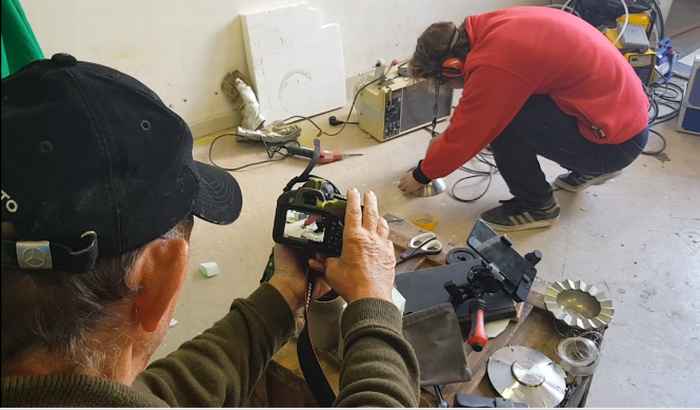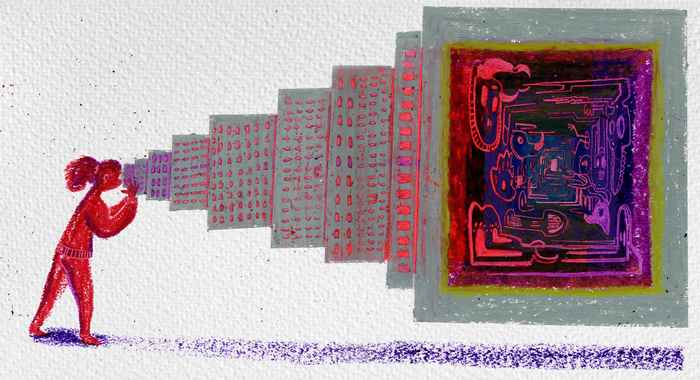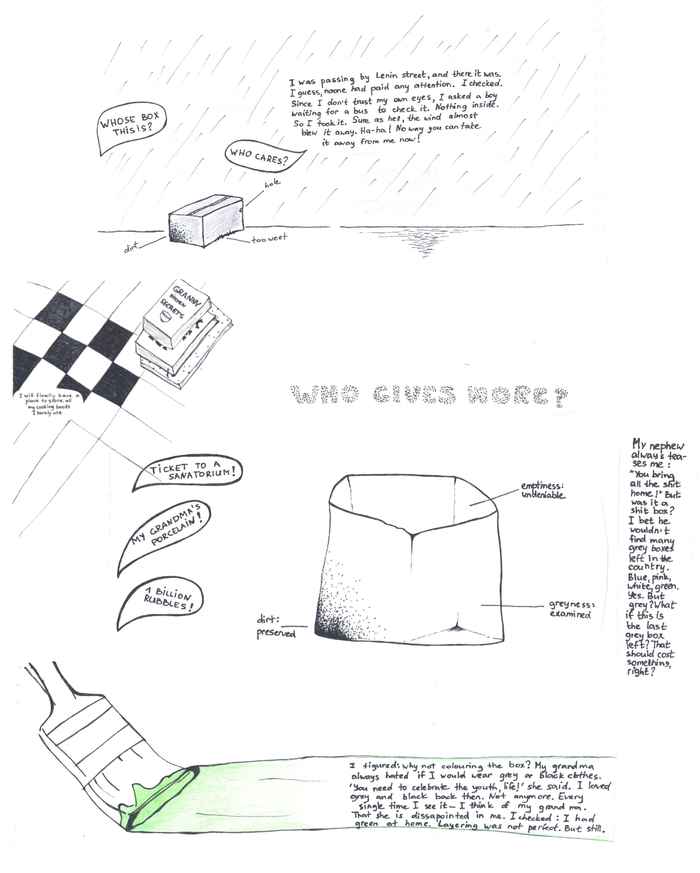How to study cities in a feminist way? Methodological experiments together with an art curator
by Fenna Smits and Anastasiya Halauniova
That update, however, needs a clear and practical manual. What does it mean to do urban research in a feminist way? Where does one start? In the absence of an instruction, we carried out a course for PhD researchers from social sciences and humanities so as to produce an easy to follow set of ‘lessons’ on how to do and communicate urban research from a feminist standpoint. With the help of an experienced art curator, Sophia Tabatadze, we explored ways to question relations between subject and object of the analysis; the ‘gaze’ of the researcher; ‘evidence’ in urban research; and finally, questions and tools that can guide feminist urban scholarship.
Joining forces with an art curator, we wanted to learn new ways to work with our findings and challenge conventional forms of presenting them. We focused particularly on how artistic strategies and practices can contribute to new modes of academic knowledge production. So, we engaged with three main questions. First, how do various media and artistic practices enable feminist urban research strategies? Second, what questions can we ask of our scholarly work in order to make the translation from science into art? Third, what forms of knowledge do we create when we work with an art curator?
We do not present a single and definitive answer to these questions here. Instead, we suggest three strategies of using artistic practice in order to recalibrate the method in urban research and make it work in a feminist way. We write about these strategies in more detail in the manual (download here), but this post gives a short overview of the suggested tricks that the reader can follow.

Let us start with a strategy that we call Doing feminist critique and intervention. This strategy entails an immersive and performative methodology of data-walking. Different from well-known go-along method or participant observation, data-walk is a narrowly focused and critical research tool. The urban exploration through data-walk will allow you to explore alternative layers of the city through a sensory and embodied approach driven by one single question with a feminist commitment. For example, one of our contributors, Tania Esteves Fernandes Cardoso, explored who and how feels belonging to a particular urban space and how one can articulate different feelings and sensibilities of (not) belonging? She used drawings, photographs, and informal conversations as those proved helpful in making visible multiple experiences of being-in and -with urban spaces. See the illustrations provided in this post to get a sense of how this seemingly simple question turns into a reflexive drawing informed by the data-walking.
This strategy, thus, will allow you to explore different questions while daring you to meaningfully engage with your surroundings, producing artistic responses initiated by this entanglement. Intervention and not observation is the aim of this strategy. During the walk, you are expected to gather information through movements, senses, rhythms, and so on, and draw, record, or even dance as a response. You need to follow your intuition and trust what ‘captures your eye’ or other parts of your body.

Another strategy that we explored during the course and cooperation with the art curator is what we call Moving beyond critique: Appreciation. Contrary to Doing feminist critique and intervention, Appreciation is not build upon one single method of gathering research materials (or what is usually considered to be ‘data’). Rather, it is a mode of building a research argument that is driven by feminist sensibility and commitment to societal change. Within this strategy, the researcher tries to develop ways to care for things and questions that touch and concern research participants. You can do so through the means of ‘speculative fabulation’ and storytelling: that is, through writing/drawing/designing/performing stories whose plots are similar to what you observed when collecting your ‘data’. By means of speculative fabulation and storytelling, you can learn to appreciate the practice that you witnessed and participated in during the fieldwork. For instance, Anastasiya Halauniova articulated how her research participants cared for and repaired the often devalued and decaying urban built environments of the socialist era in post-socialist European semi-periphery. And Fenna Smits re-articulated and appreciated the practices of her interlocutors by subverting the dominant narrative and aesthetics of the welfare state. That is to say that this strategy will allow you to incorporate pains, pleasures, hopes, and fears of people you have become closer to during your research. The stories you will create with that strategy are powerful in highlighting the tensions that are usually hidden within a ‘neat’ and ‘sanitized’ academic narrative.
Third strategy that we propose is titled Feminist collaborations: Relating. This strategy entails working together with other humans or non-human animals. Working together, however, is a marginal practice in a growingly individualized academic environment. Far from being conflict-free, collaboration allows you to start out from differences between a ‘researcher’ and the ‘researched’ and explore these differences together. Audio and visual media, for instance, allowed one of the contributors, Leonie Dronkert, to do the troubled production of knowledge together with persons who usually are explicitly excluded by the classist and ableist academia, such as individuals with mild intellectual disabilities. Artistic techniques also made us relate to non-human subjects. By turning her main research site, a river, into an artistic object, Afra Foli explored how a river can turn into an infrastructure via miniature manipulations, and she discovered invisible or hidden connections that constitute this process.
We explored these and other ways of updating the method in urban studies in the booklet that was produced in a collaboration with a collective “In the Shade of a Tree.”
Please, feel free to use it and modify it for your own feminist purposes!
